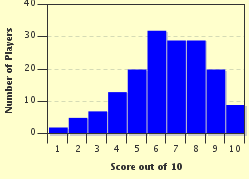Quiz Answer Key and Fun Facts
1. Which of the following options is a real example of a poorly understood weather phenomena?
2. What is indicated by the size of a hailstone?
3. Sometimes called "flying saucer clouds" what is the proper name for the unusually shaped clouds in this photo?
4. Where would it be most common to see a fire whirl?
5. What is the primary difference between a hurricane, a cyclone, and a typhoon?
6. Which of these statements about rainbows is false?
7. What is the term for these ice crystal prisms that appear on either side of the sun, sometimes giving the illusion of three suns?
8. Waterspouts are basically tornadoes over water and are usually much weaker than their terrestrial counterparts.
9. Which of the following is the best description of the weather phenomena known as a simoom?
10. What scale is used to measure the strength of a tornado?
Source: Author
dcpddc478
This quiz was reviewed by FunTrivia editor
WesleyCrusher before going online.
Any errors found in FunTrivia content are routinely corrected through our feedback system.

